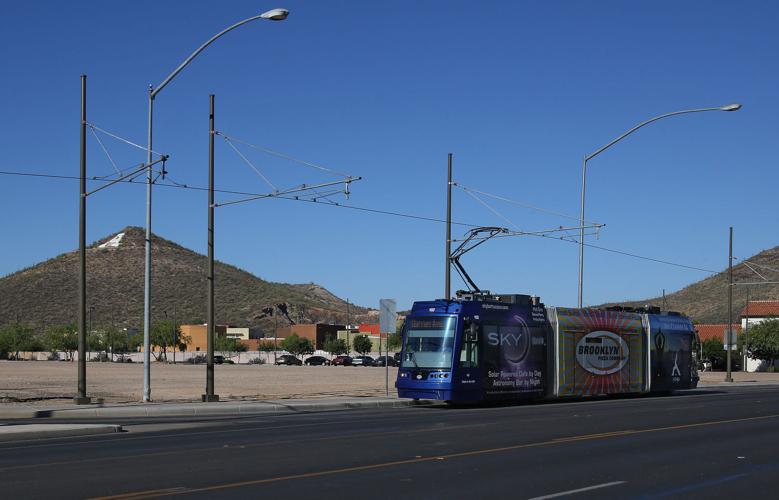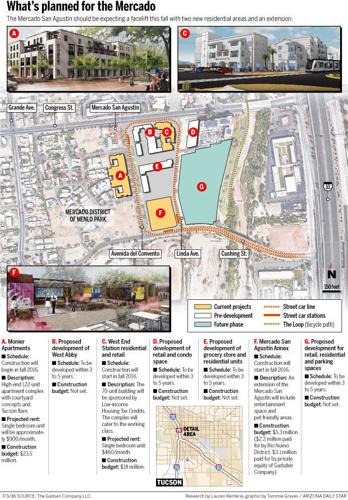New life could come to the west end of the streetcar line this fall when city officials and private developers focus their attention on empty parcels of land they say are “underutilized.”
Since the construction of the streetcar in 2014, the city has found new ways to expand access to businesses and highlight existing points of interest along the line. But there are more than 200 acres of land labeled as underutilized, which are typically old parking lots or empty parcels with development potential, said Camila Bekat, a city economic development specialist.
“Hopefully, within the next three years, we can see some substantial build-out on that end,” she said of the area west of Interstate 10 near West Congress Street.
An attempt to renovate this empty space is not new. In the past, the city has tried to start the construction process through The Gadsden Co., Bekat said, but when the housing market crashed the company was unable to make any plans come to fruition — until now.
Gadsden is set to begin construction on three projects this fall surrounding the Mercado San Agustín.
This construction is only the beginning phase of development the partners say they hope to see fill the streetcar loop and adjacent areas within the coming years.
One of the three projects to begin in the fall is the Monier Apartments complex. It will feature a four-story building with open courtyards and nearby retail space. The apartment building will be on the higher end for the area and will cost about $900 per month for a single-bedroom unit, according to Gadsden partner Adam Weinstein.
The Monier building will include “a full retail frontage — 13,450 square feet — with 122 residential units above, that are a mix of studios, ones and twos,” Weinstein said. “Then there is also an amenitized fourth floor with a gym, flex space, yoga studio, spa and a roofdeck pool.”
Meanwhile, construction on the 70-unit West End Station apartment complex is to begin about the same time. It will be part of a larger project that eventually will be a 170-unit residential building. A 70-unit segment was approved for low-income housing tax credits in June. The credits will help stabilize the rent in the building for years to come, Weinstein said.
This apartment project is targeted at working-class families and individuals who make 50 percent of the median income for Pima County residents, which is about $59,000 a year. Rent for a single-bedroom unit is projected to cost about $460 per month and will be near a streetcar stop.
“It has a lot of the same features (as Monier) that make this wonderful,” Weinstein said. “But, it’s going to be available to working families and others that meet the income requirement, and that’s the beauty of having low-income housing tax credits, is that it affords the developer to build a long-term asset for the community.”
The third planned project is the Mercado San Agustín Annex. An extension of the existing mercado, the extension will include an outdoor theater, plus food and retail vendors. Visitors might also see pet- and family-friendly areas, beer and wine hangouts and open observation decks. The project is estimated to cost about $5.3 million, with $2.2 million funded by the Rio Nuevo District, said Fletcher McCusker, the district’s chair.
“I think you’re going to see continued retail and restaurant growth,” McCusker said. “We hope that we can attract a hotel down to that part of town ... I would hope that within the next four years we can complete the entire project.”
For the partners, all three projects mean more than just building for profit — they say they want to build a space for Menlo Park residents to enjoy close to home.
“We find this sensitivity and these interesting qualities and characteristics about Tucson, in particular the disposition on the west side of downtown,” Weinstein said.
“We wanted to help be able to continue to enhance what those things are and make it a place where people want to live, want to come visit and want to be a part of.”
Menlo Park residents can also expect to see the new headquarters for Caterpillar Inc., which is expected to be located nearby. Rio Nuevo will be footing the $50 million for the construction, and McCusker says he hopes this opportunity will be profitable for the city and its taxpayers.
“All the money is ours, the whole thing is a Rio Nuevo project. Caterpillar wanted to lease, not own,” McCusker said. “It’s actually a very lucrative transaction for the taxpayers because we get high-paying jobs in Tucson.”
For Gene Einfrank, the president of the Menlo Park Neighborhood Association and a longtime resident, the new construction is something he looks forward to and hopes will bring economic growth to the neighborhood.
In fact, those in the neighborhood association acted as a catalyst for growth when they pushed to bring the streetcar to their area.
“As a neighborhood association, we worked really hard to make sure that the city brought the streetcar to the west side ... and that was really the key to unlocking development,” Einfrank said.
All of the projected development has been approved by the residents of Menlo Park, according to Einfrank. He said the residents have been extremely involved in the planning process and have spoken out about the type of development they would like to see.
The only surprise to the Menlo Park residents is the development of Caterpillar headquarters. Even though the building was unexpected, Einfrank hopes the company can work with the neighborhood and contribute to a more economically diverse area.
“It (Caterpillar) was not what we expected, but we voted unanimously, in our last neighborhood association meeting, to support a collaborative relationship with Caterpillar,” Einfrank said.
“If we can have that relationship, there can be great community benefits.”





